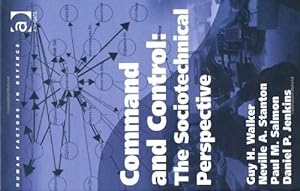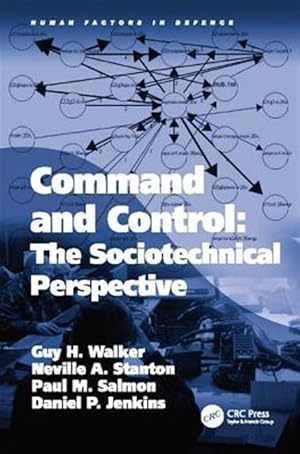Command Control Sociotechnical Perspective by Walker Guy (29 results)
Search filters
Product Type
- All Product Types
- Books (29)
- Magazines & Periodicals (No further results match this refinement)
- Comics (No further results match this refinement)
- Sheet Music (No further results match this refinement)
- Art, Prints & Posters (No further results match this refinement)
- Photographs (No further results match this refinement)
- Maps (No further results match this refinement)
- Manuscripts & Paper Collectibles (No further results match this refinement)
Condition Learn more
- New (23)
- As New, Fine or Near Fine (5)
- Very Good or Good (1)
- Fair or Poor (No further results match this refinement)
- As Described (No further results match this refinement)
Binding
Collectible Attributes
- First Edition (1)
- Signed (No further results match this refinement)
- Dust Jacket (No further results match this refinement)
- Seller-Supplied Images (13)
- Not Print on Demand (21)
Language (1)
Price
- Any Price
- Under US$ 25 (No further results match this refinement)
- US$ 25 to US$ 50
- Over US$ 50
Free Shipping
Seller Location
Seller Rating
-
Command and Control: The Sociotechnical Perspective (Human Factors in Defence)
Seller: suffolkbooks, Center moriches, NY, U.S.A.
hardcover. Condition: Very Good. Fast Shipping - Safe and Secure 7 days a week!
-
Command and Control: The Sociotechnical Perspective.
Published by Ashgate., Farnham, 2009
Language: English
Seller: EmJay Books, Bradford., United Kingdom
First Edition
Hardcover. Condition: As New. No Jacket. First Edition. xviii, 198pp, diagrams, bibliography. The integration of technology and warfare. 700g.
-
Condition: New.
-
Command and Control: The Sociotechnical Perspective (Human Factors in Defence)
Seller: Majestic Books, Hounslow, United Kingdom
Condition: New. pp. 216.
-
Command and Control: The Sociotechnical Perspective (Human Factors in Defence)
Seller: Books Puddle, New York, NY, U.S.A.
Condition: New. pp. 216.
-
Condition: As New. Unread book in perfect condition.
-
Command and Control : The Sociotechnical Perspective
Seller: GreatBookPricesUK, Woodford Green, United Kingdom
US$ 84.74
US$ 19.86 shipping from United Kingdom to U.S.A.Quantity: Over 20 available
Add to basketCondition: As New. Unread book in perfect condition.
-
Command and Control: The Sociotechnical Perspective (Human Factors in Defence)
Seller: Ria Christie Collections, Uxbridge, United Kingdom
US$ 94.62
US$ 15.86 shipping from United Kingdom to U.S.A.Quantity: Over 20 available
Add to basketCondition: New. In.
-
Command and Control : The Sociotechnical Perspective
Seller: GreatBookPricesUK, Woodford Green, United Kingdom
US$ 91.06
US$ 19.86 shipping from United Kingdom to U.S.A.Quantity: Over 20 available
Add to basketCondition: New.
-
Command and Control: The Sociotechnical Perspective
Published by Taylor & Francis Ltd, 2017
ISBN 10: 1138076864 ISBN 13: 9781138076860
Language: English
Seller: THE SAINT BOOKSTORE, Southport, United Kingdom
Paperback / softback. Condition: New. New copy - Usually dispatched within 4 working days.
-
Command and Control: The Sociotechnical Perspective (Human Factors in Defence)
Seller: Biblios, Frankfurt am main, HESSE, Germany
Condition: New. pp. 216.
-
COMMAND AND CONTROL: THE SOCIOTECHNICAL PERSPECTIVE
Seller: Revaluation Books, Exeter, United Kingdom
Paperback. Condition: Brand New. 216 pages. 9.21x6.14x0.55 inches. In Stock.
-
Command and Control: The Sociotechnical Perspective (Human Factors in Defence)
Seller: Mispah books, Redhill, SURRE, United Kingdom
Paperback. Condition: New. NEW. SHIPS FROM MULTIPLE LOCATIONS. book.
-
Command and Control: The Sociotechnical Perspective (Human Factors in Defence)
Published by CRC Press 2009-11-28, 2009
ISBN 10: 0754672654 ISBN 13: 9780754672654
Language: English
Seller: Chiron Media, Wallingford, United Kingdom
Hardcover. Condition: New.
-
Condition: New.
-
Command and Control: The Sociotechnical Perspective (Human Factors in Defence)
Seller: Lucky's Textbooks, Dallas, TX, U.S.A.
Condition: New.
-
Command and Control : The Sociotechnical Perspective
Seller: GreatBookPricesUK, Woodford Green, United Kingdom
US$ 222.71
US$ 19.86 shipping from United Kingdom to U.S.A.Quantity: Over 20 available
Add to basketCondition: As New. Unread book in perfect condition.
-
Command and Control : The Sociotechnical Perspective
Seller: GreatBookPricesUK, Woodford Green, United Kingdom
US$ 250.10
US$ 19.86 shipping from United Kingdom to U.S.A.Quantity: Over 20 available
Add to basketCondition: New.
-
Condition: As New. Unread book in perfect condition.
-
Command and Control: The Sociotechnical Perspective (Human Factors in Defence)
Seller: Ria Christie Collections, Uxbridge, United Kingdom
US$ 260.80
US$ 15.86 shipping from United Kingdom to U.S.A.Quantity: Over 20 available
Add to basketCondition: New. In.
-
Command and Control: The Sociotechnical Perspective
Seller: Revaluation Books, Exeter, United Kingdom
Hardcover. Condition: Brand New. new edition edition. 216 pages. 9.53x6.22x0.75 inches. In Stock.
-
Command and Control: The Sociotechnical Perspective
Seller: PBShop.store US, Wood Dale, IL, U.S.A.
PAP. Condition: New. New Book. Shipped from UK. THIS BOOK IS PRINTED ON DEMAND. Established seller since 2000.
-
Command and Control: The Sociotechnical Perspective
Seller: PBShop.store UK, Fairford, GLOS, United Kingdom
PAP. Condition: New. New Book. Delivered from our UK warehouse in 4 to 14 business days. THIS BOOK IS PRINTED ON DEMAND. Established seller since 2000.
-
Command and Control | The Sociotechnical Perspective
Seller: preigu, Osnabrück, Germany
Taschenbuch. Condition: Neu. Command and Control | The Sociotechnical Perspective | Guy H Walker (u. a.) | Taschenbuch | Einband - flex.(Paperback) | Englisch | 2017 | CRC Press | EAN 9781138076860 | Verantwortliche Person für die EU: Libri GmbH, Europaallee 1, 36244 Bad Hersfeld, gpsr[at]libri[dot]de | Anbieter: preigu Print on Demand.
-
Command and Control : The Sociotechnical Perspective
Seller: AHA-BUCH GmbH, Einbeck, Germany
Taschenbuch. Condition: Neu. nach der Bestellung gedruckt Neuware - Printed after ordering - Military command and control is not merely evolving, it is co-evolving. Technology is creating new opportunities for different types of command and control, and new types of command and control are creating new aspirations for technology. The question is how to manage this process, how to achieve a jointly optimised blend of socio and technical and create the kind of agility and self-synchronisation that modern forms of command and control promise. The answer put forward in this book is to re-visit sociotechnical systems theory. In doing so, the problems of 21st century command and control can be approached from an alternative, multi-disciplinary and above all human-centred perspective. Human factors (HF) is also co-evolving. The traditional conception of the field is to serve as a conduit for knowledge between engineering and psychology yet 21st century command and control presents an altogether different challenge. Viewing military command and control through the lens of sociotechnical theory forces us to confront difficult questions about the non-linear nature of people and technology: technology is changing, from platform centric to network centric; the interaction with that technology is changing, from prescribed to exploratory; and complexity is increasing, from behaviour that is linear to that which is emergent. The various chapters look at this transition and draw out ways in which sociotechnical systems theory can help to understand it. The sociotechnical perspective reveals itself as part of a conceptual toolkit through which military command and control can be transitioned, from notions of bureaucratic, hierarchical ways of operating to the devolved, agile, self-synchronising behaviour promised by modern forms of command and control like Network Enabled Capability (NEC). Sociotechnical system theory brings with it a sixty year legacy of practical application and this real-world grounding in business process re-engineering underlies the entire book. An attempt has been made to bring a set of sometimes abstract (but no less useful) principles down to the level of easy examples, design principles, evaluation criteria and actionable models. All of these are based on an extensive review of the current state of the art, new sociotechnical/NEC studies conducted by the authors, and insights derived from field studies of real-life command and control. Time and again, what emerges is a realisation that the most agile, self-synchronising component of all in command and control settings is the human.
-
Command and Control: The Sociotechnical Perspective
Seller: PBShop.store UK, Fairford, GLOS, United Kingdom
US$ 261.53
US$ 6.65 shipping from United Kingdom to U.S.A.Quantity: Over 20 available
Add to basketHRD. Condition: New. New Book. Delivered from our UK warehouse in 4 to 14 business days. THIS BOOK IS PRINTED ON DEMAND. Established seller since 2000.
-
Command and Control: The Sociotechnical Perspective
Seller: PBShop.store US, Wood Dale, IL, U.S.A.
HRD. Condition: New. New Book. Shipped from UK. THIS BOOK IS PRINTED ON DEMAND. Established seller since 2000.
-
Command and Control | The Sociotechnical Perspective
Seller: preigu, Osnabrück, Germany
Buch. Condition: Neu. Command and Control | The Sociotechnical Perspective | Guy H Walker (u. a.) | Buch | Einband - fest (Hardcover) | Englisch | 2009 | CRC Press | EAN 9780754672654 | Verantwortliche Person für die EU: Libri GmbH, Europaallee 1, 36244 Bad Hersfeld, gpsr[at]libri[dot]de | Anbieter: preigu Print on Demand.
-
Command and Control : The Sociotechnical Perspective
Seller: AHA-BUCH GmbH, Einbeck, Germany
Buch. Condition: Neu. nach der Bestellung gedruckt Neuware - Printed after ordering - Military command and control is not merely evolving, it is co-evolving. Technology is creating new opportunities for different types of command and control, and new types of command and control are creating new aspirations for technology. The question is how to manage this process, how to achieve a jointly optimised blend of socio and technical and create the kind of agility and self-synchronisation that modern forms of command and control promise. The answer put forward in this book is to re-visit sociotechnical systems theory. In doing so, the problems of 21st century command and control can be approached from an alternative, multi-disciplinary and above all human-centred perspective. Human factors (HF) is also co-evolving. The traditional conception of the field is to serve as a conduit for knowledge between engineering and psychology yet 21st century command and control presents an altogether different challenge. Viewing military command and control through the lens of sociotechnical theory forces us to confront difficult questions about the non-linear nature of people and technology: technology is changing, from platform centric to network centric; the interaction with that technology is changing, from prescribed to exploratory; and complexity is increasing, from behaviour that is linear to that which is emergent. The various chapters look at this transition and draw out ways in which sociotechnical systems theory can help to understand it. The sociotechnical perspective reveals itself as part of a conceptual toolkit through which military command and control can be transitioned, from notions of bureaucratic, hierarchical ways of operating to the devolved, agile, self-synchronising behaviour promised by modern forms of command and control like Network Enabled Capability (NEC). Sociotechnical system theory brings with it a sixty year legacy of practical application and this real-world grounding in business process re-engineering underlies the entire book. An attempt has been made to bring a set of sometimes abstract (but no less useful) principles down to the level of easy examples, design principles, evaluation criteria and actionable models. All of these are based on an extensive review of the current state of the art, new sociotechnical/NEC studies conducted by the authors, and insights derived from field studies of real-life command and control. Time and again, what emerges is a realisation that the most agile, self-synchronising component of all in command and control settings is the human.
















